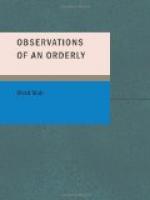Some years ago a number of public buildings were earmarked for hospital use in case of war. It may surprise the indignant patriots to learn that any preparations whatever were made prior to the outbreak in 1914. Nevertheless all kinds of preparations actually were made. Mistakes and miscalculations may have marred those preparations: the fact remains that, as far as the Territorial Medical Service was concerned, the authorities had merely to press a button and hospitals came into existence. Thus a number of institutions—mostly schools—found themselves ejected from their own roof-trees: found, in short, (what many other folk were to learn later) that the State is omnipotent in war-time and that sectional interests fade into insignificance compared with the interests of the safety of the commonwealth. Some conception of the promptness with which this paper scheme of Sir Alfred Keogh’s materialised at the outbreak of war may be gathered from the simple statement that the building of which I myself write was an Orphans’ Home on August 4th, 1914. At 6 a.m. on August 5th it was a military hospital.
I do not say that it was a military hospital in working order. But if, by a miracle, wounded had turned up then, there was at least a staff of medical officers and orderlies on the premises to receive them. In point of fact it was some weeks before the first patients arrived. Those weeks, however, were not idle ones. The layman who considers that any large building can be turned instantaneously into a hospital would have had an eye-opener if he had witnessed the work done here. The mere removing of 95 per cent. of the institution’s furniture was a colossal task; added thereto was the introduction of hundreds of beds, hundreds of mattresses, hundreds of sets of bedclothes, hundreds of suits of pyjamas, hundreds of—But why prolong a brain-racking list? Then there was the pulling-down and fixing-up of partitions, the removal of every single window for replacement by Hopper sashes, the fitting-in of bathrooms, lavatories, ward-kitchens, sink-rooms, dispensary, cookhouse, operating-theatre, pathological laboratory, linen-store, steward’s store, clothing-store, detention-room, administration offices, X-ray department ... all these in a building which, spacious and handsome outwardly, was, as to its interior, a characteristic maze in the Scottish baronial style of architecture beloved by mid-Victorian philanthropists. How the evicted orphans will like to return to those stone-flagged




